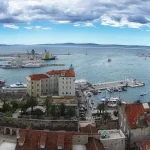August 22, 2019 – Over 170,000 ships and boats sail the Adriatic Sea each year, with more than a third of that traffic in Split waters.
The crowds are monitored daily by the Split Port Authority with 15 outposts. The Port Authority is an umbrella organization in maritime affairs, so apart from traffic control, it issues licenses for the management of vessels, keeps records of ships, boats, and yachts, and conducts search and rescue at sea.
Dalmacija Danas spoke with Captain Željko Kuštera about the role of this institution and the challenges they face in their work each day.
“The Split area is made up of 7,200 square kilometers of sea and a coast of 1,100 kilometers in length. We are in charge of a huge area, from Makarska to Trogir plus the islands to Palagruža, where the largest traffic on the Adriatic takes place. Besides being in charge of surveillance and search and rescue, we also have an inspection department, a legal department dealing with the registration of ships, boats and yachts and a general affairs department. We issue about 10,000 certificates, two and a half thousand nautical booklets and about a thousand and a half sentences for boat managers. An incredible amount of people go through this building daily, it’s a boardwalk, and everyone is in an emergency, everyone is in a hurry. That’s the hardest part of the job. And when you look at it, it’s only done by the 65 people we have employed at the Split Port Authority and all 15 outlets.”
How many days does the Port Authority have to go out on search and rescue interventions? Is the organization adequately equipped?
“Since the beginning of the year, we have had 89 search and rescue operations, and there could be a dozen of them every day. We have one boat and five smaller boats arranged, as we like to say, in the golden hour, so that we can react at any time in the Split waters. At any moment we know where our ships are and how many people and ships we have, we have really raised this organization to a higher level. In terms of equipment, I would give it a rating of 3 out of 5, but we offset it all by man. We have great cooperation with other services, and our people are competent and willing to work, so we raise that three to five.”
Does the Port Authority have enough human resources to cover all of Split?
“We’re not complaining. It is said in Dalmatia “cover yourself with the chain you have”. I wish I could get another 20 employees now, but with what we have, we cover everything. People are tired, we don’t have fixed hours because you go out to sea when needed, we also have actions that can last for several days… but we are well organized, so it works. Given that tourism, including nautical tourism, is rapidly evolving, we can expect to grow in terms of human resources and new equipment.”
What causes maritime accidents most often?
“Most often they happen when we have storms, and lately there are frequent fires on boats, which is a concern. There are more and more electronics on ships, which can spark a fire. With this amount of traffic mistakes happen, it’s hard to avoid, so the most important thing is good organization on our part so that we can help at any time.”
Who gives the Port Authority the biggest headaches at sea?
“Definitely those who speed too close to the coast, but also when passengers are transferred in restricted areas where the safety of bathers is directly endangered. Even swimmers know how to swim outside the bordered area, putting themselves at risk, and some go diving and do not put markers.”
How many speeding fines did the Port Authority write this year?
“We issued HRK 850,000 in fines, which doesn’t make me happy. By comparison, last year, HRK 650,000 in fines were charged. This is worrying because it is a big amount, but it also means that the number of offenses is increasing. People are irresponsible at sea as in any traffic, but our goal is not to print fines, but to reduce such occurrences.”
Among other things, the Port Authority is responsible for the inspection of vessels. Recently, the media has said that some cruisers are allegedly releasing fecal water by Zlatni Rat in Bol. Did the inspectors supervise? How many fecal discharges have been issued this year?
“Last year, seven penalties for discharging sewage water were issued, but this year, we have not had any cases. Swimmers and other people think they see it. Last week we went out on a call, and it turned out to be pine needles. I don’t blame people, when you look from afar, it really looks like pollution, and the citizens immediately think its oil or feces. It is incomprehensible to me that people in tourism release feces around swimmers. It is known exactly when and where this is done and how, and inspectors constantly monitor it. We are really moving forward on this issue, but we need to be constantly alert and work on prevention.”
How generally satisfied is Kuštera with the situation on Croatia’s coast in terms of maritime traffic?
“We have an amazing staff in the maritime industry. We are a small country, and our sailors sail around the world over and over and over and over again, listening to competent and well-educated people. But everyone is sailing on our coast today. People rent a boat, use GPS … by law they must have maps, but the question is how much they know how to read. Just see how they hold a navigational triangle. But that has come about in every business… I am not against growth and development, but there need to be measures in place.”
To read more about travel in Croatia, follow TCN’s dedicated page.








